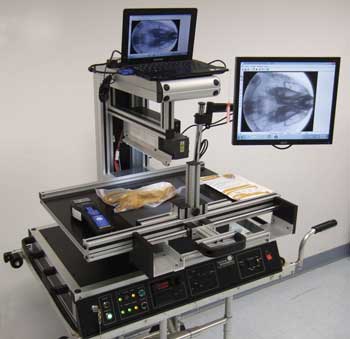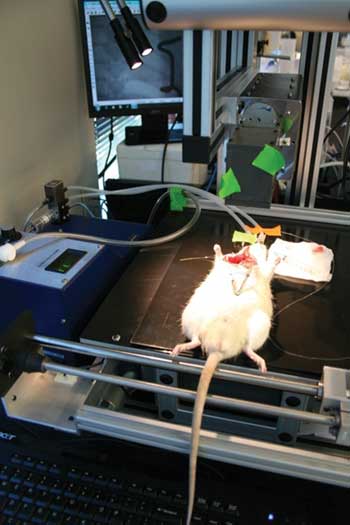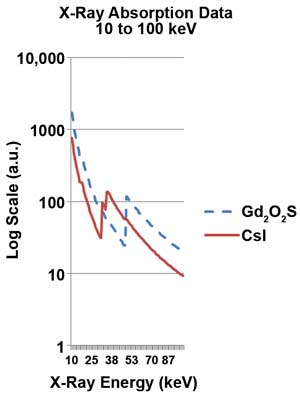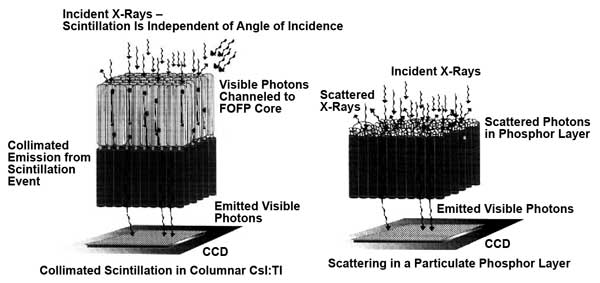James Tomlinson, Applied Scintillation Technologies Ltd.
Thin-film CsI:Tl coatings offer real-time high-resolution video, enabling discoveries in medical research trials.
Advances in x-ray imaging techniques are bringing benefits to in vivo imaging applications. One such advance is LabScope, a high-resolution, low-dose magnifying x-ray fluoroscopic system that uses a thallium-doped cesium iodide (CsI:Tl) scintillator. The system,1 from Glenbrook Technologies Inc. of Randolph, N.J., has led to groundbreaking clinical research trials. It records video in real time, so it performs what is termed true fluoroscopy.

The LabScope from Glenbrook Technologies Inc. is a high-resolution, low-dose magnifying x-ray fluoroscope system. Courtesy of Glenbrook Technologies.
Using this technique, pioneering preclinical pathology studies are investigating the aftereffects of myocardial infarction in rats by performing coronary angiograms of their hearts. Traditionally, angiograms use image intensifiers or flat panel detectors to convert the x-ray energy into light via the interaction with a scintillator. Flat panel solutions typically use a gadolinium oxysulfide (Gd2O2S) or CsI scintillator to convert the radiation into light before photodiodes or amorphous silicon thin-film transistor (TFT) technology converts the light into electrical signals that can be viewed on a screen. These systems offer resolution of, typically, four line pairs (a line and a space) per millimeter (lp/mm) – that is, the maximum number of line pairs that can be distinguished as separate lines in a millimeter of width.
Magnification fluoroscopy
In contrast, magnification fluoroscopy is a relatively new technique, operating in effect as an x-ray microscope that can achieve up to five times the intrinsic resolution of fluoroscopic systems. A magnification fluoroscope consists of a scintillator coupled to a nondemagnifying image intensifier. The intensified image is then viewed by an autofocus, programmable-zoom CCD camera. The closed-circuit camera transmits the high-resolution, magnified video image to a computer for image processing and real-time viewing.

The LabScope has performed an angiogram of a rat’s heart in preclinical pathology studies into the aftereffects of myocardial infarction in rats. Courtesy of Glenbrook Technologies.
The system has been used in research to test the hypothesis that injecting the resorbable liquid polymer IK-5001 into the heart after a myocardial infarction can prevent the adverse remodeling of the left ventricle of the heart; this remodeling can lead to the heart’s enlargement and deformation and, subsequently, to congestive heart failure. The polymer works by breaking down calcium deposits and flushing them from the system. Without the ability to resolve precise detail in real time using the high-resolution magnifying fluoroscope, the first-ever recorded coronary angiogram video of a rat’s heart would not have been possible.
Other fluoroscopy systems deliver a much higher radiation dose to the subject and imaging team, as the obtainable resolution is comparatively low and one method of increasing the discernible detail is to increase the x-ray beam intensity.1
The magnification fluoroscopy system displays significant benefits over these traditional fluoroscopes: It operates at lower x-ray energies, significantly reducing the radiation dose delivered, and still achieves high-resolution (20-lp/mm) video or static images because of the construction of the system and the scintillator material used.

The LabScope setup used for the rat coronary angiogram. Courtesy of Glenbrook Technologies.
Scintillator materials for fluoroscopy
A range of x-ray phosphor materials have traditionally been associated with imaging. Rare-earth oxysulfide phosphors such as yttrium oxysulfide (Y2O2S) and Gd2O2S came to prominence in the 1970s and have long been used in screen/film combination systems. Terbium-doped Gd2O2S, also known as Gadox, has become a very popular phosphor for use in imaging. Gadox coatings can be manufactured in a variety of manners including via Web techniques. For finer imaging requirements, such as those in fluoroscopy, Gadox materials can be applied to substrates such as fiber optic plates, or tapers, by sedimentation deposition, spraying or doctor blade methods. Sedimentation typically offers the best resolution of the manufacturing methods.
Magnifying fluoroscopes have, until recently, used terbium-doped Gd2O2S scintillator coatings. This material delivers acceptable resolution without blurring, as the decay time and persistent afterglow of the phosphor are suitable for real-time imaging. However, one drawback is the sharpness (or contrast) of the obtained video, because of the inherent amorphous structure of the phosphor, which can contain multiple particle grain sizes, contributing to light scatter after interaction with an x-ray beam. Typical CsI:Tl scintillators offer better resolution than Gd2O2S alternatives, but the afterglow/decay of the material results in an effect called image lag, or ghosting.

Clinical studies performed on a rat. Courtesy of Glenbrook Technologies.
To achieve high frame rates without image blur, a scintillator with low phosphor persistence is required. Fluorescence persistence, afterglow or lag, leads to blurring of images because the scintillator retains a residue of previous images.
The solution is to incorporate a CsI:Tl polycrystalline scintillator providing excellent resolution; the material is grown under specific evaporation conditions (in vacuum deposition chambers) to ensure that an exceptional columnar structure is achieved with uniform column dimensions. When this is achieved, outstanding image quality, sharpness and resolution will result: After excitation by x-rays, the luminescence generated in the CsI:Tl luminescent centers is transmitted through the tightly packed columns, reducing scatter in comparison to Gadox solutions, and resulting in extremely high resolution images with sharp contrast.
The CsI:Tl coating is grown directly onto a fiber optic plate to assist in channeling (collimating) the luminescence generated after excitation by x-rays. It provides the added benefit of absorbing x-ray photons and consequently protecting the underlying electronic device from radiation damage; this also leads to lower noise. A benefit of the material is its ability to be grown (vacuum deposited) over larger areas. This is only limited by the size of the deposition chamber and the cost of the associated vacuum systems. Accordingly, the material is suitable as a replacement technology for large-area fluoroscopy systems, replacing older image-intensifier options.

X-ray absorption of CsI:Tl and Gadox. Courtesy of Applied Scintillation Technologies.
The thin-film CsI:Tl coating used in this magnification fluoroscopy system does not exhibit the image lag that has been associated with typical CsI:Tl scintillators. This means that there is no need to co-dope the material with decay- and afterglow-reducing components such as samarium,2 europium3 or bismuth,4 which are known to result in reduced luminescence intensity and a shift in emission wavelength, both of which would make the material less suitable for real-time imaging applications at low doses.
The x-ray absorption of CsI:Tl is better than that of Gadox between 33 and 50 keV. This is termed the K-absorption edge, the point at which x-ray absorption increases and captured photons are more likely to liberate electrons from the K-shell. The K-absorption edge is 36.0 for cesium and 33.2 for iodine, providing an almost perfect match. The absorption for the constituent materials in Gadox is not as well-matched in the region specified above, and therefore CsI:Tl is better suited for low-energy systems and applications such as fluoroscopy with real-time high-resolution video, which enables discoveries in medical research trials.

Point-spread function in CsI:Tl and Gadox. Courtesy of Applied Scintillation Technologies.
Future developments
The LabScope magnifying fluoroscope system will continue to assist in cutting-edge research beyond recording an angiogram of a rat’s heart. The technique is set to help researchers explore topics such as dysphagia, a swallowing disorder often suffered as a result of a stroke.
Future improvements in the system’s performance might also include optimizations to the scintillator coating thicknesses or exploring different substrate materials such as fiber optic glass types. Theoretically, changing such parameters could optimize the scintillator material for use at lower x-ray energies and bring further benefits to the magnifying fluoroscope system in comparison with alternative fluoroscopic equipment. Other avenues of exploitation for the CsI:Tl scintillator will build on success in such application areas as intraoral, panoramic and cephalometric dental imaging.
Meet the author
James Tomlinson is part of the business development team at Applied Scintillation Technologies Ltd., responsible for marketing activities; email: [email protected].
References
1. G. Zweig (2008). US Patent No. 7,426,258 B1. United States.
2. V.V. Nagarkar et al (2008). Scintillation properties of CsI:Tl crystals codoped with Sm2+. IEEE Transactions on Nuclear Science, Vol. 55, No. 3, pp. 1270-1274.
3. E.E. Ovechkinaa et al (2007). Multiple doping of CsI:Tl crystals and its effect on afterglow. Rad Meas, Vol. 42, pp. 541-544.
4. T.Y. Daisuke Totsuka et al (April 20, 2012). Afterglow suppression by codoping with Bi in CsI:Tl crystal scintillator. Appl Phys Exp 5, pp. 052601-1-052601-3.